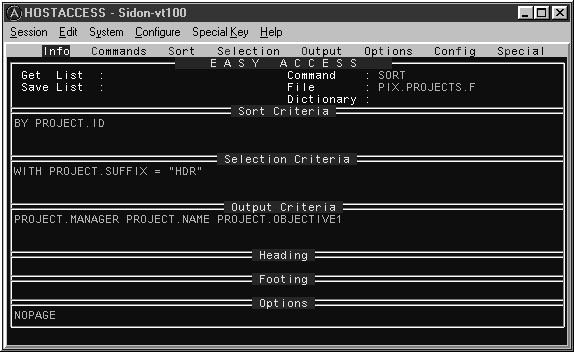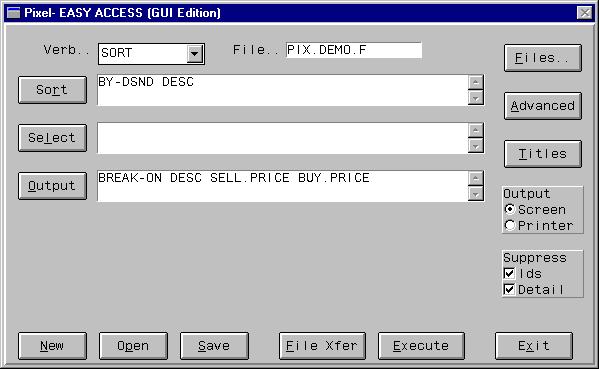EASY.ACCESS and EASY.ACCESS.GUI
EASY.ACCESS is a powerful user-friendly front-end for all versions of PICK's inbuilt enquiry language, available in both a non-GUI (EASY.ACCESS) and GUI form (EASY.ACCESS.GUI). It may be used to create and execute enquiry sentences for:
|
INFORM |
Prime INFORMATION |
|
ENGLISH |
McDonnell Douglas REALITY |
|
ACCESS |
PICK R83 |
|
RetrieVe |
VMark UniVerse |
|
RECALL |
Ultimate |
|
Uniquery |
UniData |
EASY.ACCESS supports all of the enquiry commands in ALL the PICK flavours. Developers have full control of which commands are presented to the user and may modify (or remove) the command descriptions available to the user to construct sentences.
Specific tables of commands and modifiers have been prepared especially for UniVerse and Prime INFORMATION users and these are selected automatically to match the machine type you are running on.
Help in EASY.ACCESS is available for certain commands and options by calling TCL HELP (only if standard HELP is supported on that system). If help is requested for a Dictionary Definition, the definition is displayed within a pop-up window.
EASY.ACCESS has been integrated with HostAccess's PASS.TO DOS and Windows facilities, to allow the result of virtually any enquiry to be automatically transferred into DOS or Windows applications including databases, spreadsheet products and word processors.
The data extraction and transfer is completely automatic and includes:
-
Taking the user into the DOS or Windows product.
-
Importing the transferred data.
-
Presenting the user with the result (for example, a LOTUS 3-D pie-chart).
When using the PASS.TO facilities, the relevant DOS or Windows product will be called and the data imported, e.g. PASS.TO.LOTUS.
Some "PASS.TO" routines only create a DOS file and do not call a DOS or Windows product. For example, PASS.TO.DIF will create a DIF file under DOS in the file called PIXELnnn.TMP (where 'nnn' is the PICK user's port number) in the current HostAccess directory.
EASY.ACCESS interface

Starting EASY.ACCESS
To start EASY.ACCESS, invoke it from the TCL command line as follows:
EASY.ACCESS {filename} {group} {(options}
Where:
|
filename |
Optional name of data file for which inquiries will be constructed. This can also be specified from within EASY.ACCESS. |
|
group |
Dictionary groups can be set up as records in the dictionary of filename. These records allow you to logically group together dictionaries. i.e. SALES, COSTS. And, more importantly, groups can be used to restrict access to certain areas of the dictionary. |
Using the word ALL overrides any groups and will present the user with ALL of the dictionaries found in the file.
|
(options |
Anything following the open left round bracket is treated as an option. Multiple options can be specified with or without a comma delimiter. Most of the options are designed to be set when EASY.ACCESS is CALLED as a subroutine from other applications. These options can be as follows
|
||||||||||||||
Using EASY.ACCESS
All of EASY.ACCESS's facilities are presented to the user in friendly pop-down menus and selection boxes. Users are guided through these menus in a logical but efficient manner when constructing enquiry sentences. The ease of use of the menu system is one of EASY.ACCESS's strongest points. Use of just the arrow keys, <RETURN> and <ESCAPE>, allows the user to quickly access and select the menu options required.
A number of function keys are provided for general use throughout the menus, which may be used instead of moving to the appropriate menu option. At the top most level of EASY.ACCESS main menus, these are:
|
F5 |
Process sentence. |
|
F10 |
Help on currently highlighted option or dictionary definition (if system supports HELP command from TCL). |
Other function keys available while reviewing (amending) parts of the constructed sentence are:
|
F1 |
Amend text/option. |
|
F2 |
Delete text/option. |
|
F3 |
Move text/option. |
|
F8 |
Restore text/options. |
The <ESCAPE> key should be used to return from lower menu levels or to exit from EASY.ACCESS when at the top menu level.
You may review the various component parts of the final sentence at any point. For example, you may wish to change the Selection Criteria - simply select Review from the Selection menu.
Dictionary groups can be used to 'break-up' a very large list of dictionary items into smaller and more manageable groups.
Dictionary Groups are records defined in the Dictionary of the file being used by EASY.ACCESS. They have the following format:
|
Key |
PIX.GROUP.groupname. |
|
Field 1 |
Group description. |
|
Field 2 |
Multi-valued list of Dictionary Definition keys belonging to this group, these should really exist in the dictionary of the file to ensure valid sentences are constructed. |
Where:
|
Groupname |
User defined name for this group (e.g. SALES, DEPARTMENTS) - the file containing the group name must be prefixed by "PIX.GROUP." and thus is selected automatically by EASY.ACCESS for use by the users. |
|
Group description |
Up to 60 characters describing this group - this is the text that will be presented to the user when working with groups. |
These Dictionary Groups should be entered into the appropriate Dictionary files.
Sentences may be saved and recalled by selecting the relevant options from the CONFIG menu. Any saved sentences are stored in the file File: PIX.EASY.ACCESS.F which normally points back to the main HostAccess account. This file can be created in the local account if preferred.
You may also specify that the data file be inquired upon by using another Dictionary definitions file (uses generic PICK USING construct).
Selecting and processing one of the 'pass to PC' application options tells EASY.ACCESS to call HostAccess's data extraction command GET and then call the relevant PASS.TO routine.
EASY.ACCESS Applications Integration
EASY.ACCESS is processed by the subroutine PIX.EASY.ACCESS which may be called by any PICK program, as follows:
CALL PIX.EASY.ACCESS(TCL.INPUT,TCL.OPTIONS)
Where:
|
TCL.INPUT |
May be null or any of the command line parameters described above (i.e. PRICES SALES) for the SALES group from the PRICES file. |
|
TCL.OPTIONS |
May be null or any of the command line options described above i.e. C132F to FORCE only the SALES group from the PRICES file, 'C'learing the last sentence and switching HostAccess into 132 column mode first. |
Program Example
*
* Program to call EASY.ACCESS using the file PRICES and
* force the user to only look at the SALES group of
* dictionaries. Where PIX.GROUP.SALES exists in the
* dictionary of the file PRICES containing the list of
* dictionaries in that group as a multi-value array etc.
*
* The 'C' option tells EASY.ACCESS to clear the previous
* sentence first and start with an empty statement.
*
CALL PIX.EASY.ACCESS("PRICES SALES","C")
*
EASY.ACCESS.GUI interface
EASY.ACCESS.GUI is the new GUI version of EASY.ACCESS. EASY.ACCESS.GUI makes data extraction and reporting even easier than before with an intuitive interface that enables you to build reports quickly.

Starting EASY.ACCESS.GUI
To start EASY.ACCESS.GUI, invoke it from the TCL command line as follows:
EASY.ACCESS.GUI
For further information, contact your HostAccess reseller.